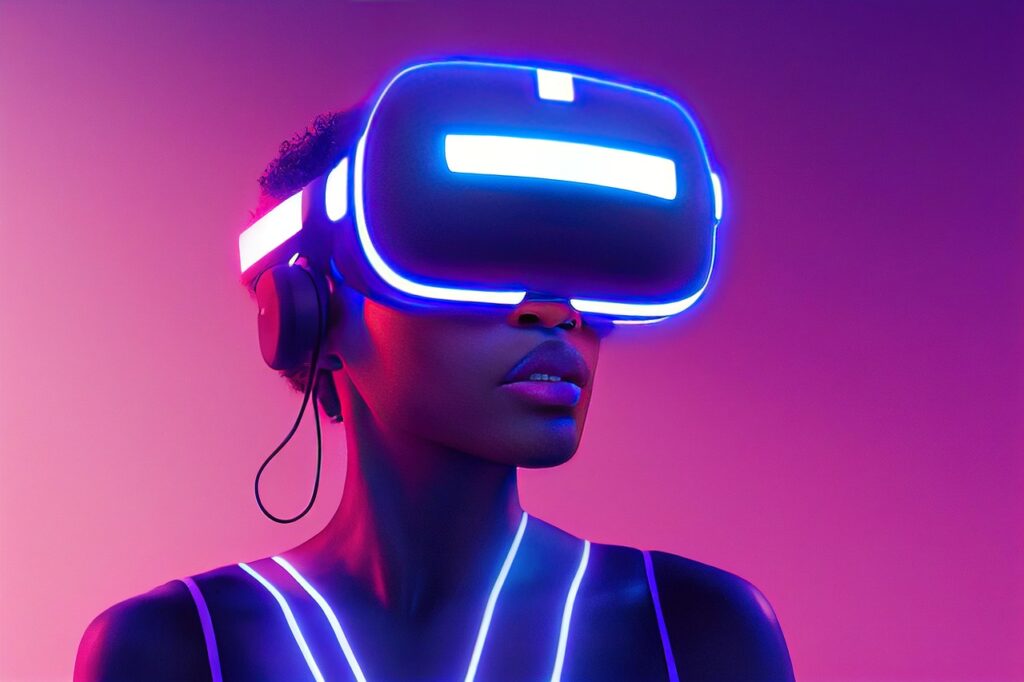How businesses conduct training have evolved dramatically in recent years. From traditional classroom-based sessions to webinars and e-learning platforms, the options for delivering training have become increasingly interactive thanks to advancements in technology. One of the most effective training methods to emerge from these developments is using virtual reality (VR). The global Virtual Training and Simulation market size was valued at USD 296632.11 million in 2022 and is expected to expand at a CAGR of 12.02% during the forecast period, reaching USD 586244.18 million by 2028. VR technology provides a level of immersion and engagement that can significantly enhance the learning process for employees of all levels. Additionally, you can further explore AR training as well.
In terms of engagement, VR training shows a 75 % engagement rate, thus performing better than any other form of training except for teaching other people.
What is VR Training?
VR training is a form of interactive training that allows users to experience a simulated environment in real time. VR uses headsets and often hand-held controllers or haptic feedback devices to create an immersive experience. Users can explore virtual environments, engage in interactive experiences, and undertake skills-based training. This level of engagement significantly increases the effectiveness of the training and its potential impact.
The Benefits of VR Training for Businesses
Businesses of all sizes can benefit from using VR as a training tool, as well as augmented reality training. By harnessing the technology, companies can improve training processes and overall employee performance. Some of the key benefits of VR training for businesses include:
1. Improved Retention Rates
VR training is much more immersive than many other training methods, and the level of engagement it provides can lead to much higher retention rates. Studies have shown that individuals are more likely to remember information and skills when they learn in a virtual environment, which can reduce the overall time and resources required for training.
VR learners are 3.75 times more emotionally connected to the content than classroom learners and 2.3 times more connected than e-learners.
2. Higher Workspace Safety
Many jobs have a highly risky environment for which the employees need to be prepared, yet it’s not easy to create the same conditions in the physical environment to train them, which is why VR comes perfectly. VR training tools help companies make their training programs safer, more convenient, and more effective. It enables mental repetitions in specific conditions that feel like real life, making it a perfect approach for such critical moments. It has been proven that VR learners are 275% more confident in applying skills learned after training.
3. Enhanced Learning Experiences
Users can interact with and explore the virtual environment, which can provide a more engaging and interactive learning experience than traditional training methods. This makes it particularly effective for hands-on or scenario-based courses, where users can experience situations in real time.
4. Faster Learning and Skill Development
Thanks to the high level of immersion and engagement provided by VR training, users may learn and develop new skills more quickly. The level of detail and realism present in the virtual environment can help employees practice a range of tasks and scenarios that would be challenging or impossible to experience in real life.
5. Cost-Effective Training
VR training is particularly useful for companies with employees across multiple locations. Rather than traveling to a central location for training, employees can use VR headsets to access training programs from their own location. This can save businesses significant time and expenses by offering a cost-effective remote training solution.
6. Improved Customer Service
Customer satisfaction is essential for every big company, so it’s crucial to have well-trained customer service. But often, all these employees get is a manual with instructions or a few lessons. VR training helps customer service agents by affording them on-demand practice, learning both the practical and productive procedures and the soft skills, such as empathy and communication skills, to handle all types of customers they may encounter. It helps them develop their critical thinking skills and adjust to customer demands.
VR Training in Different Industries
VR training programs apply to many industries, so 39% of big organizations leverage virtual and augmented reality training software to facilitate training in simulated environments. Many positive examples of VR industrial training can be pointed out, like police officers who received virtual training are 2.7 times more likely to participate in successful missions. What other industries are taking advantage of this new immersive technology in their learning initiatives?
Healthcare
Healthcare is one of the sectors where virtual reality training can be highly beneficial. Microsoft used Hololens and developed a training program that redefined healthcare education. It’s claimed to revolutionize how medical students can understand the anatomy of a body and see how parts relate to each other. At YORD, we created a VR CPR training app in collaboration with the Red Cross. This VR simulation can provide a realistic and immersive way for individuals to learn and practice this lifesaving technique. It is currently being used by the Red Cross as part of their formation with volunteers.
Retail
Virtual reality and augmented reality technologies have transformed retail in so many ways. Within a competitive sector, it’s essential to use the newest trends and all of the modern technology at your disposal. One of the more successful training examples is Walmart, which used the Oculus Rift headset and gaming PC. Oculus training uses 360-degree video-based technology that includes on-screen cues that will prompt staff to make decisions based on real-world situations. In this case, virtual reality training programs prepared employees for situations such as the Black Friday rush or customer service scenarios.
Manufacturing
In manufacturing, various aspects of training can be improved with virtual training technology. With manufacturing, one wrong move can have harmful consequences. Employees who are unfamiliar with machine controls are prone to injure themselves as well as their co-workers. A great example is the company Airbus, where the implementation of VR training enabled them to reduce the duration of maintenance processes by 25%.
Virtual Reality training allows manufacturing workers to grasp the system and develop an efficient equipment operation routine. It’s also an excellent tool for instructors to monitor their performance.
Hospitality & Tourism
Discovering a new destination is now easier than ever with Google Maps and other online tools. Virtual reality tools take this to the next level by allowing us to walk around goals worldwide. There are various ways in which the hospitality and tourism industry can benefit from implementing virtual reality training. Still, the most significant benefit is soft skills training since soft skills are essential for this industry. A great example of companies using virtual reality training in the hospitality industry is Honeygrow, a fast-casual restaurant chain. VR provided trainees with a tour of a Honeygrow location with a 360-degree view while employees listened to the company’s values from the Founder and CEO of the company.
👋 Get your AR project started
Fill out our contact form below and get started on your project with YORD team.
Implementing VR Training at Your Business
As VR technology continues to develop, the costs of implementing VR training programs at businesses have significantly decreased. Leading technology companies such as Microsoft and Oculus now offer enterprise-focused VR headsets and other equipment specifically designed for corporate training. Additionally, a number of development companies offer customization and content creation tools to help businesses develop their own training programs.
To implement VR training at your business, you’ll need to consider the range of applications that could be beneficial to your employees. In YORD, we can help you with that! The options might include scenario-based training programs, safety and compliance simulations, customer interaction training, and more. Once we’ve determined the type of training you’ll need, we can begin exploring the range of equipment and development services available to you.
Conclusion
VR training can significantly increase the effectiveness of training programs for businesses of all sizes. The level of immersion and engagement provided by VR technology can improve retention rates, enhance learning experiences, and create faster learning and skill development. When implementing a VR training program, businesses should consider the range of applications and equipment available. As VR technology continues to develop, the opportunities for creating fully immersive and interactive training experiences will continue to expand. Now it is your turn to make a change with YORD!
👋 get in touch
By clicking the “send” button, I agree to the collection and processing of my personal data as described in the Privacy Policy.





